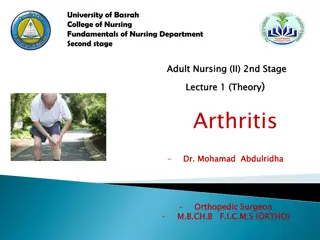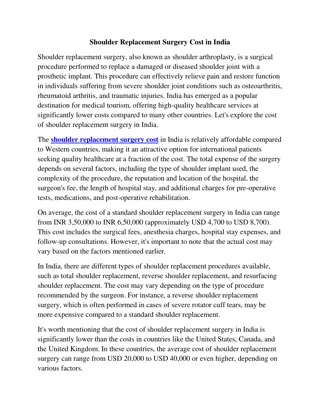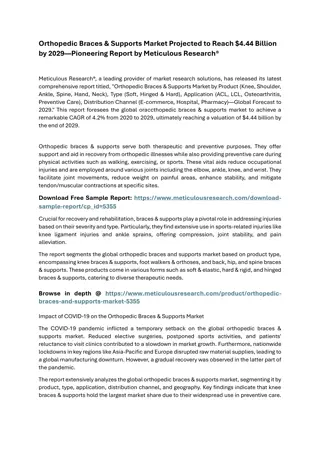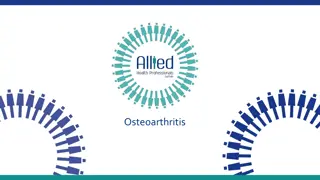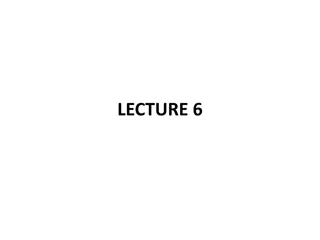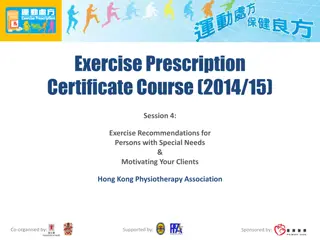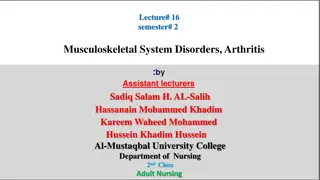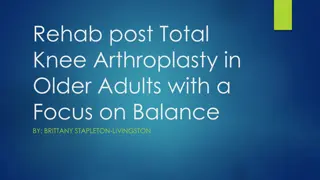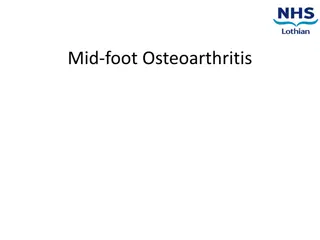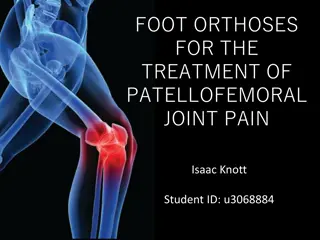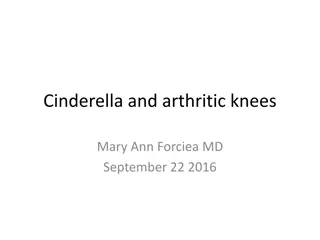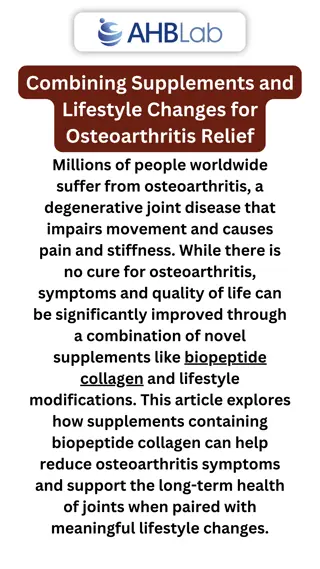Osteoarthritis
Osteoarthritis is a common joint disease affecting various populations, with higher prevalence in women. It involves weight-bearing and non-weight-bearing joints, causing changes in articular cartilage, subchondral bone, and synovium. Synovial joints play a crucial role in joint function and protection. Understanding the epidemiology and anatomy of osteoarthritis is essential for effective management.
Download Presentation

Please find below an Image/Link to download the presentation.
The content on the website is provided AS IS for your information and personal use only. It may not be sold, licensed, or shared on other websites without obtaining consent from the author.If you encounter any issues during the download, it is possible that the publisher has removed the file from their server.
You are allowed to download the files provided on this website for personal or commercial use, subject to the condition that they are used lawfully. All files are the property of their respective owners.
The content on the website is provided AS IS for your information and personal use only. It may not be sold, licensed, or shared on other websites without obtaining consent from the author.
E N D
Presentation Transcript
Osteoarthritis RIZWAN MANSOOR M.D. CONSULTANT RHEUMATOLOGIST
OA - Definition Heterogeneous group of conditions resulting in common histopathologic and radiologic changes involving Entire joint organ, including: the articular cartilage the subchondral bone and the synovium.
Epidemiology Internationally, osteoarthritis is the most common articular disease. Estimates of its frequency vary across different populations. 80-90% of individuals older than 65 years have evidence of radiographic osteoarthritis. the prevalence of osteoarthritis is higher among women than among men. Interethnic differences in the prevalence of osteoarthritis have been noted.
Involved joints Weight-bearing joints, including: the knees the hips cervical and lumbosacral spine feet. Non weight bearing joints: the(DIP), the(PIP), and the(CMC) joints.
Synovial Joints Articular cartilage Subchondral bone Synovial membrane Synovial fluid Joint capsule
The normal articular surface of synovial joints articular cartilage ( chondrocytes) surrounded by extracellular matrix includes proteoglycans and collagen. The cartilage facilitates joint function and protects the underlying subchondral bone by distributing large loads, maintaining low contact stresses, and reducing friction at the joint.
Synovial Fluid Synovial fluid is formed by (synoviocytes). Synovial cells also manufacture hyaluronic acid (HA, also known as hyaluronate), a glycosaminoglycan that is the major noncellular component of synovial fluid. Synovial fluid supplies nutrients to the avascular articular cartilage; it also provides the viscosity needed to absorb shock from slow movements provides elasticity required to absorb shock from rapid movements.
Pathogenesis Swelling of the cartilage usually occurs the level of proteoglycans eventually drops very low, the cartilage softens and lose elasticity and compromising joint surface integrity. Flaking and fibrillations (vertical clefts) develop along on the surface of an osteoarthritic joint. Over time, the loss of cartilage results in loss of joint space. a greater loss of joint space occurs at those areas experiencing the highest loads.
Bone changes Bone denuded of its protective cartilage continues to articulate with the opposing surface. Eventually, the increasing stresses exceed the biomechanical yield strength of the bone. The subchondral bone responds with vascular invasion and increased cellularity, becoming thickened and dense (a process known as eburnation) at areas of pressure.
Bone changes subchondral bone undergo cystic degeneration. Osteoarthritic cysts are also referred to as subchondral cysts, pseudocysts, or geodes and may range from 2 to 20 mm in diameter. Osteoarthritic cysts in the acetabulum are termed Egger cysts.
Joint changes vascularization of subchondral marrow, osseous metaplasia of synovial connective tissue, and ossifying cartilaginous protrusions lead to irregular outgrowth of new bone (osteophytes). Fragmentation of these osteophytes or of the articular cartilage itself results in the presence of intra-articular loose bodies (joint mice).
Etiology Risk factors- Age, obesity,trauma, genetics, hypogonadism, muscle weakness, repetitive use, Infection, crystal deposition, acromegaly, previous inflammatory arthritis (burnt-out rheumatoid arthritis) Heritable metabolic causes (alkaptonuria, hemochromatosis, Wilson disease)Hemoglobinopathies (sickle cell disease and thalassemia)Neuropathic disorders leading to a Charcot joint (syringomyelia, tabes dorsalis, and diabetes)Underlying morphologic risk factors (congenital hip dislocation and slipped femoral capital epiphysis) Disorders of bone (Paget disease and avascular necrosis)Previous surgical procedures (meniscectomy)Diabetes mellitus[44]
Osteoarthritis Progression Stage 1- breakdown of the cartilage matrix occurs. Stage 2 - involves the fibrillation and erosion of the cartilage surface Stage 3 - a chronic inflammatory response in the synovium. Further Progression - the above events alter the joint architecture, compensatory bone overgrowth occurs. joint architecture is changed mechanical and inflammatory stress occurs on the articular surfaces, the disease progresses unchecked.
Differential Diagnosis Crystalline arthropathies (ie, gout and pseudogout) Inflammatory arthritis (eg, rheumatoid arthritis) Seronegative spondyloarthropathies (eg, psoriatic arthritis and reactive arthritis) Septic arthritis or postinfectious arthropathy Fibromyalgia Tendonitis
Work Up Laboratory Plain Radiography CT scan, MRI scan, ultrasonography Bone scintigraphy Arthrocentesis
Treatment Non pharmacologic- Life style modification, physical and rehab therapy Pharmacotherapy Arthroscopy Osteotomy Arthroplasty Fusion and joint Lavage Stem cell therapy
References 1.1.Hunter, W. Of the structure and diseases of articulating cartilages. Phil. Trans. Royal Soc. 470, 514 521 (1743). 2.2.National Collaborating Centre for Chronic Conditions (UK). 3.National Clinical Guideline for Care and Management in Adults(Royal College of Physicians of London, 2008). 3.3.Felson, D. T. An update on the pathogenesis and epidemiology of osteoarthritis. Radiol. Clin. North Am. 42, 1 9 (2004). 4.4.WHO. The World Health Report 2002: reducing risks, promoting healthy life (WHO, 2002). 5.5.Centers for Disease Control and Prevention (CDC). Prevalence of doctor-diagnosed arthritis and arthritis-attributable activity limitation United States, 2010 2012. MMWR Morb. Mortal. Wkly Rep. 62, 869 873 (2013).


